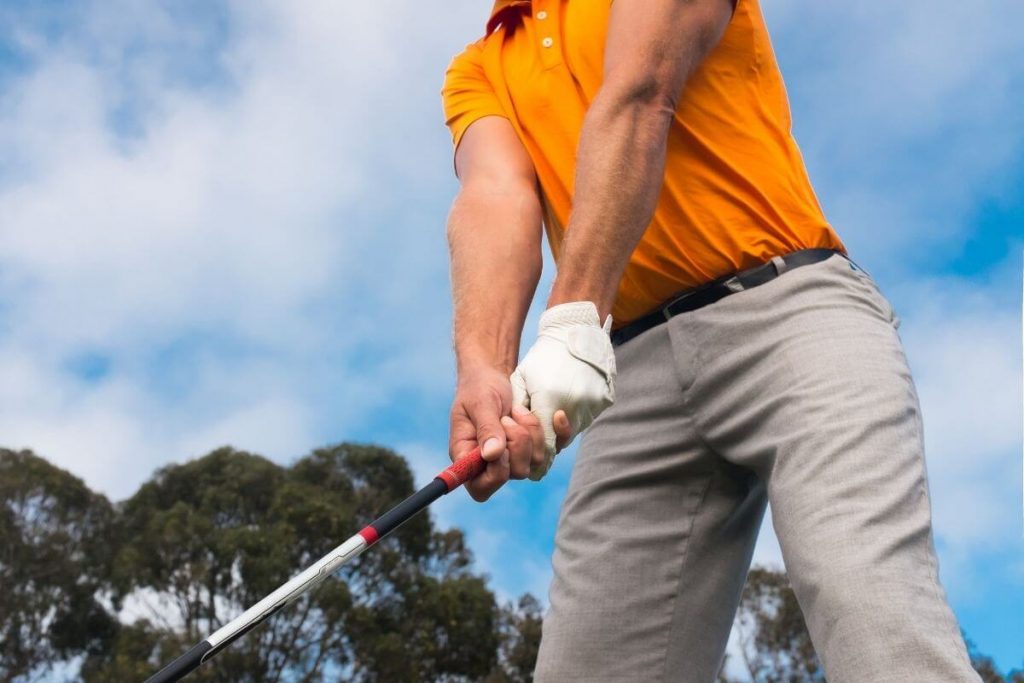Gripping your golf club correctly is the first and most important phase of your swing. The position of your hands on the club will permit the control of the orientation of the clubface at the moment of impact.
Having the right grip allows you to maintain control of the golf club and the path of the golf swing takeaway. On the other hand, the wrong grip causes the clubface to move the wrong way at impact, which can result in mishits, duck hooks and slices.
There are three different types of golf grips which all have their different purposes. These are the overlapping grip, the interlocking grip and the 10 finger grip.
In this article we shall be discussing each of these grips in detail so you can make the most out of your golf swing.
Table of Contents
The 10 Finger Grip
The 10 finger is the most basic grip used to hold the golf club. As the name suggests, this involves using all your 10 fingers to grip the club at the same time and with the same amount of pressure.
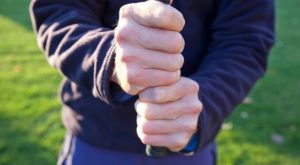
Also known as the baseball grip, the 10 finger is the oldest and most natural grip that has been around since the 15th century. It is recommended for most beginners due to it’s simplicity, and is even used by professional golfers on the PGA Tour. The 10 finger grip sets the foundation for the interlocking and overlapping grip as we will discuss later.
Steps To Take
The 10 finger grip should begin about one finger width from the end of the club, or more, for shorter controlled shots. When the hands are together, the club should lie along the callous pad line of the hands and not in the palms. When the hands are closed around the club, the thumbs should be aligned straight down the club grip.
Your forearms should form a “V” down toward the club. For right-handed players, the left hand is first placed with the beelike end of the club’s grip snuggling under the fat heel of the hand.
The club’s grip then runs diagonally across the palm, touching the last joint of the middle finger and thence across the middle joint of the first finger.
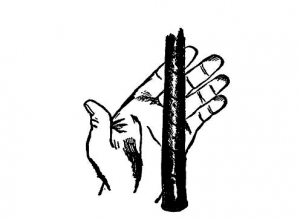
To get authority from the fingers and still salvage the power of the hand, the shaft lies across both the fingers and the palm, diagonal to the knuckles.
The left hand is then turned over the top of the shaft until the inverted “V” formed by the thumb and forefinger points diagonally across the body toward the right shoulder. Strong players, those with exceptional hand action, may point the “V” between the right shoulder and the right cheek.
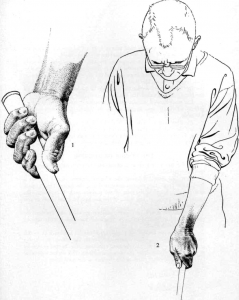
The grip and the left hand
The thumb of the left hand acts as a set screw, pressing against the shaft at an angle of about 30° behind the top of the shaft.
With the left hand in the proper position, we now place the right hand against the back side of the shaft in a vertical position. Twine the right-hand fingers around the shaft so that the shaft crosses each finger at the middle joint.
Pros And Cons Of The 10 Finger Grip
This grip is the most natural of all the three grips and is perfect for beginners. This often leads to a more relaxed stroke.
Moreover, the grip has a greater impact power as all ten fingers are holding the club which will transfer power from the arms to the club at the point of impact.
You can get a lot of shot power from this grip as it offers more wrist flexibility and a bigger snap through in your golf swing. Too much wrist flexibility though can reduce the control you have over the club and cause mishits. Therefore, it is not wise to depending too much on the wrists for shot power.
Another drawback to the 10 finger grip is that your hands are independent of each other and can sometimes lead to power imbalance if you don’t apply the right strength and discipline. Unlike the interlocking and overlapping grip, your hands are not connected in the 10 finger grip which could mess up the swing sequence, resulting in a bad shot.
The Overlapping Grip
A lot of professional golfers these days tend to use the overlapping grip more often than the others. If you have large hands then you ought to consider using this grip. Tiger Woods who is arguably the greatest golfer of all time utilizes this grip quite often in his games and had many successes with it.
The main concept of the overlap grip is to take your right pinky finger and place it on top of the gap between your index finger and the middle finger on your left hand.
It should look something like this:
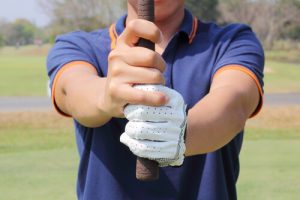
This grip is also called the ‘Vardon Grip’ which was named after Harry Vardon who was a prominent British professional golfer who helped to revolutionize the sport in the 20th century. This grip is now taught in almost all golf lessons and is adapted by the majority of today’s PGA golf players.
Steps To Take
Start with the 10 finger grip. The little finger of the right hand should overlap the first finger of the left hand, but not hook completely.
In the overlapping grip, the inverted “V’s” of both hands should be closed to prevent the club from slipping toward the palm of the hands during the swing. In other words, the thumbs should act as set screws against which the fingers can securely pull the shaft of the club.
If you have gripped the golf club correctly, only the first two knuckles of your left hand will be visible. Also, your left thumb should be completely hidden under your right hand. The index finger position of your right hand will look and feel like a gun trigger finger.
Pros And Cons
The overlapping golf grip increases the control you have over both of your wrists and allows them to move as one without reducing their freedom.
Due to the overlapping of the pinky finger, this hold is typically suited for players with longer fingers and bigger hands.
The only disadvantage of using this grip would be for players with small hands as it would be difficult for them to overlap their pinky finger, thus causing discomfort which can throw off the whole swing entirely.
The Interlocking Grip
The interlocking golf grip is done by fitting your right pinky finger between the index and middle finger of your left hand. This type of grip is good for golfers with small hands and it gives them more control over the golf club. This is perfectly suited for children and female golfers because they usually have smaller hands and will make for a more comfortable grip.
The main advantage of the interlocking grip is that it locks the hands and wrists together, thereby allowing both hands to effectively act as one unit, unlike the 10 finger grip.
It not only offers greater control, but it reduces the tension on the club. For example, the 10 finger method will often require more pressure on the grip, whereas the interlocking grip will naturally help you hold it. With the interlocking grip, you won’t have to worry about choking the club as it allows for a more fluid swing.
Image showing interlocking grip
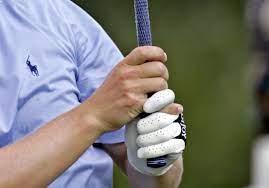
Like all the other grips, the interlocking does have it’s disadvantages. For those with bigger hands, it can feel very awkward and uncomfortable trying to perform this grip. It also reduces the power you get from snap through mainly due to the reduction of wrist movement.
What’s The Right Grip Pressure?
Gripping the club too tight could throw off your entire swing. Although there is no hard fast rule as to how firmly the golfer should grip the club, the prevailing belief is that it should be loose, yet firm enough to keep it from moving in your hands.
The swing will naturally cause the hands to strengthen the grip, so try to keep “loose grip” in your mind throughout the swing. Because there is no rulebook on the grip, it is just one of those aspects of the game that the golfer will have to experiment with, and adjust, through repetitive practice and play.
Through practice, the grip is something that should become second nature to the golfer. It is not something that should require as much thought as other aspects of the golf swing, but its importance should never be forgotten. It is recommended that you always keep a club nearby, and just practice applying and reapplying the grip over and over.
If your golf grip pressure is right, the club could almost be pulled out of your hands, but not quite. A correct golf grip will make you feel as if you are holding the club mostly in the palm and last three fingers of your left hand.
Regardless, both hands should hold the club with equal pressure. A correct golf grip doesn’t guarantee a successful golf swing; however, a defective golf grip will almost always result in a failed golf swing.

